- August 19, 2020
- Posted by: Shane Daly
- Category: Trading Article
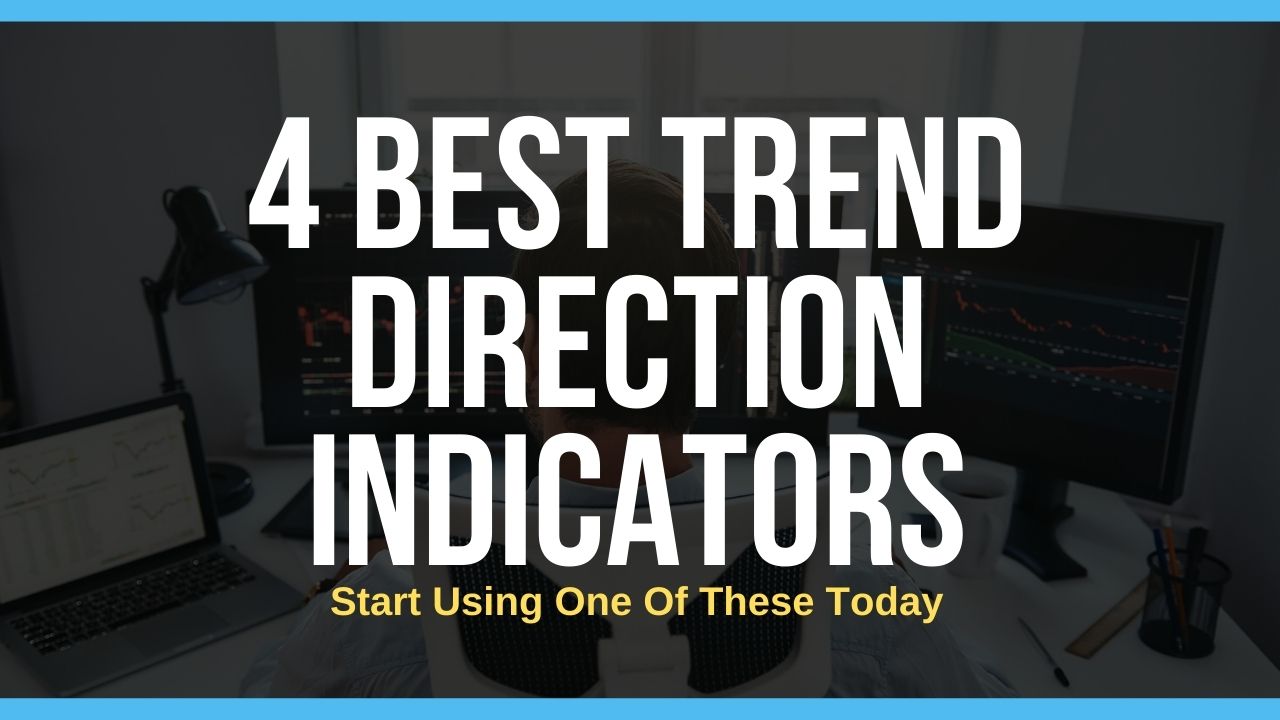
What trend indicator should you use to show the trend direction if you want to trade with the flow of price?
The first question you should ask is “what time frame are you talking about?”
With that question, you are realizing that the direction of the trend on a daily chart, for example, can be the complete opposite as the one on an hourly chart. Every investor has their own unique preferences. New investors may want to start with cheaper stocks so they can build a more diverse portfolio.
Before you focus on which trading indicator to use for trend direction, choose your time frame.
Different Time Frame = Different Trend Direction
As mentioned, before you even consider trend direction, please consider the time frame you will trade with your trading strategy.
Are you day trading using 15 minute charts or lower?
Is swing trading your strategy with 4 hour and daily charts?
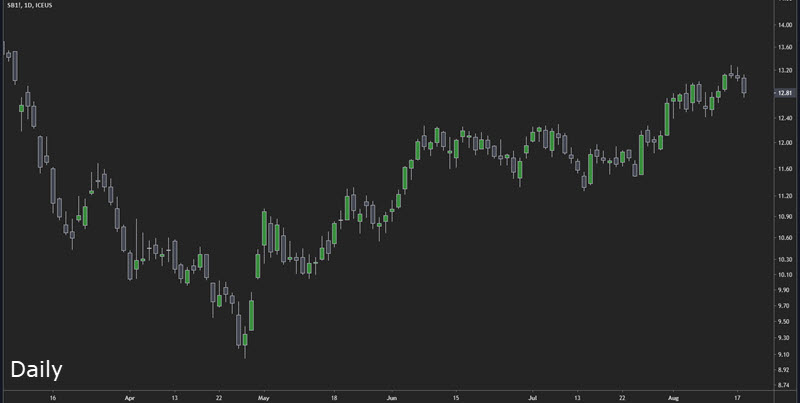
If I was trading sugar futures on the daily chart, I’d want to be looking for a buy signal after the momentum thrust and gap price move off the bottom. Price is obviously going up and short trades would be painful.
Let’s contrast that with a day trading chart.
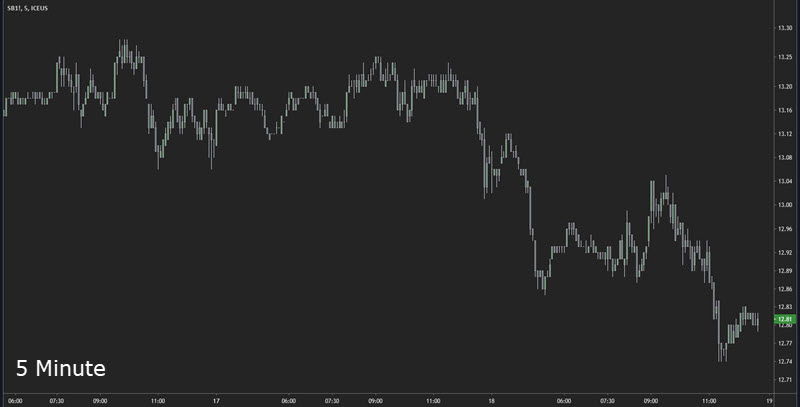
If I am trading a 5 minute chart of sugar, it is pretty clear I’d want to be looking for a sell signal and not be a buyer.
Be very clear in your trading style and consider using trend indicators on your trading time frame OR trade in the direction of the time frame a few levels up.
Why Should You Use Trend Trading
Traders looking for bigger returns know that the path of least resistance is in the direction of the big money. Leaving aside higher frequency trading algorithms that will quickly jump from long to short and back again, at home traders will find going with the trend, an easier road.
Is there a benefit to grabbing a trend reversal?
Sure.
Can you pick tops and bottoms consistently?
While you may jump in at the right moment at times, grabbing the less stressful “meat of the move” is a better bet. In order to grab the middle of the move, you must know the current trend direction for your trading time frame.
I will gladly take less stress over the constant stop outs of trying to pick the turning point.
Trend Indicator – Look At The Chart
Seems simple but one thing that doesn’t lag price, is price itself. I find price to be the best indicator for trend direction and it just takes an understanding of the price action.
First, let’s understand what a price action trend looks like:
- Uptrends have higher highs and higher lows
- Downtrends have lower highs and lower lows
- Ranges have a combination of both
One look at a chart should give you a quick read on the overall market direction. Yes, a gut feel can work as well.
Did a consolidation just break out to the upside? What trend direction do you think that is showing?
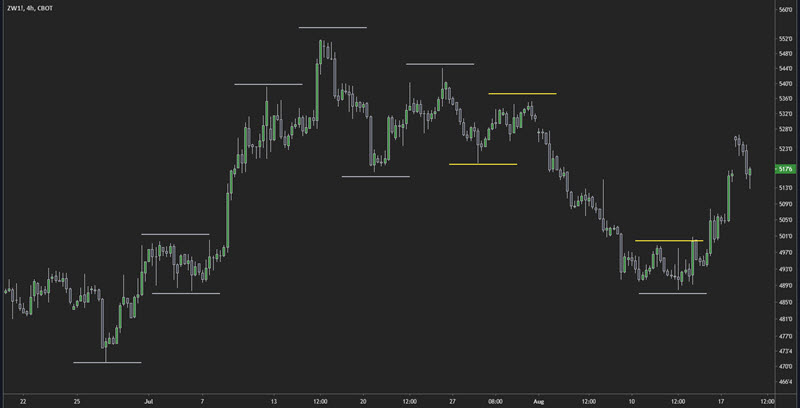
Can you see on the left the consolidated breakout with momentum to the upside?
Middle of the chart, with the yellow lines, shows a consolidation and breakdown.
The left side of the chart again shows a consolidation with a breakout to the upside.
With a quick glance at the chart, what does your gut say price is doing?
Use A Line Chart
A line removes the candles or bars and just plots the closing price of the instrument.

Removing the clutter of colours and highs and lows makes the price action even more obvious. I was able to add another grey line on the left as a support level of a trading range was more obvious.
I find the swings are much easier to see due to the points made when price changes direction.
While I would not use a line chart for entries or exits, it does give you a good indication of the trend direction including sideways markets. Swing trading and day trading can both take advantage of the clean look to the line chart for your trend determination.
Trend Lines
I want to include trend lines along with price action. While trend lines are not a trend indicator in the complete sense, they can be important if you are looking for a more visual method.
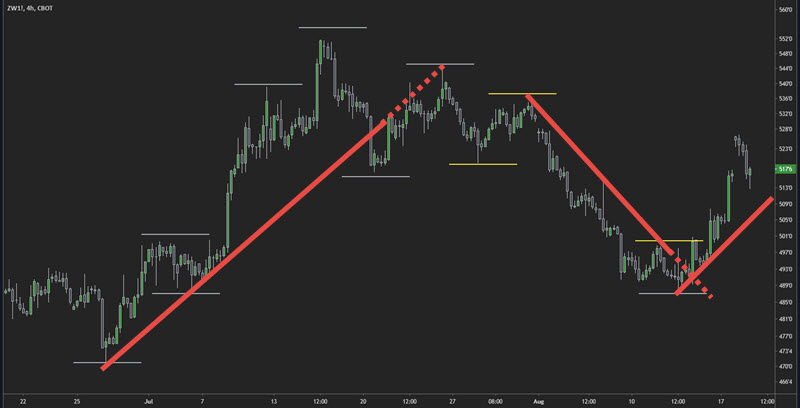
I kept it simple and used the extreme low for the first line, the range in the middle is obvious, and lines for the remaining trends. You can “fan” trend lines to ensure you include the last swing into highs or lows.
The dashed line shows where the first trend is in jeopardy as price broke the trend line and then retested the backside.
The second solid line would have been adjusted to include the price spike in the middle of the downtrend.
The last trend line is just connecting lows.
The secret is to ensure you have trend line drawing rules that you do not deviate from.
Using Moving Averages As A Trend Indicator + Strength Meter
The most common method people use for a trend indicator is a moving average. Whether you use something like the Hull moving average or the more common simple and exponential averages, they are a fast way to determine your trend.
There is no magic in a moving average as it simply calculates, with different formulas, the average price over a set number of periods.
Sustained increase in the average price = uptrend
Sustained decrease in the average price = downtrend
Price whipping around the moving average = price range
Not only can you choose your style of moving average, you also choose your look back period.
Long term trend direction – 200 periods/100 periods
Medium term direction – 50 period average
Shorter term trend direction – 5-20 periods
A shorter term average is going to flip from long to short more often than a longer term moving average. This is why you must be clear on the type of trader you are.

You can see that when you use a moving average, not only does your charting time period matter, but so does the look back period.
You also must decide what a change in trend looks like:
Will you use the slope of the moving average?
Does price have to simply close above or below to change your trend?
Do you need several of the averages to line up?
We have multiple trend directions using the moving averages on this chart.
The choice for you is how active do you want to be?
Can you live with missing a large part of a move when using a longer term average?
Can you handle being whipsawed as the shorter average alternates between buys and sells?
Using the 20 simple moving average will have you looking to short while the 200 SMA is still looking long. You would still need to have a buy signal or sell signal line up according to your trading plan.
How To Identify Trend Strength With Moving Averages
Using 2 averages, such as the 20 and 50 period, can help you gauge the strength of the trend, When the 20 pulls away from the 50, price is advancing at a steady rate and you can consider that to be a strong trend.
When the 2 moving averages are wrapped around each other, you have a trading range.
Also consider how far price pulls away from the 20 period average. The further price gets from an average price, the more risk there is of a mean reversion (pullback) in price.
You can choose to keep it very simple: is the moving average heading, generally, in one direction over another? That’s your trend.
Moving Average Convergence Divergence (MACD)
I have written about the MACD in the past and I think it is something to consider especially if you use it on a higher time frame.
In our example, we will use the default setting of 12, 26, 9 and will remove the histogram. I will also use the daily chart for setups but the weekly chart of trend direction.
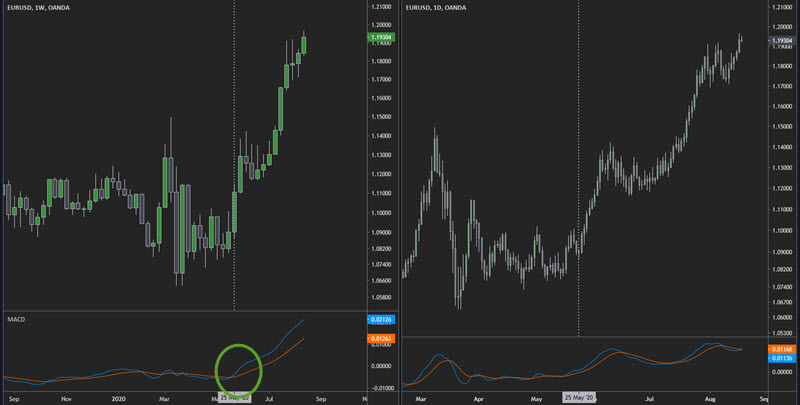
Once the MACD crosses to the upside (the green circle) on the weekly, the trend indicator is showing the current trend as long and we are looking for buy signals on the daily chart.
You will see the downside cross on the daily chart (fast line down through the slow line) where we see a pullback. We look to get long according to our trading strategy.
On the daily chart, we can use the MACD to show consolidation as the lines of the indicator get tight. That said, as long as we are seeing the separation of the lines of the MACD on the weekly, we consider we are seeing a strong trending market to the upside.
Directional Movement Indicator – DMI
The DMI is not only a decent trend indicator but with the addition of the ADX, we can also see the strength of the current trend.
I picked a daily stock chart for this example that also takes into account an ascending triangle chart pattern. Learning how to use price patterns/price action with trading indicators is a “level up” in your trading abilities.
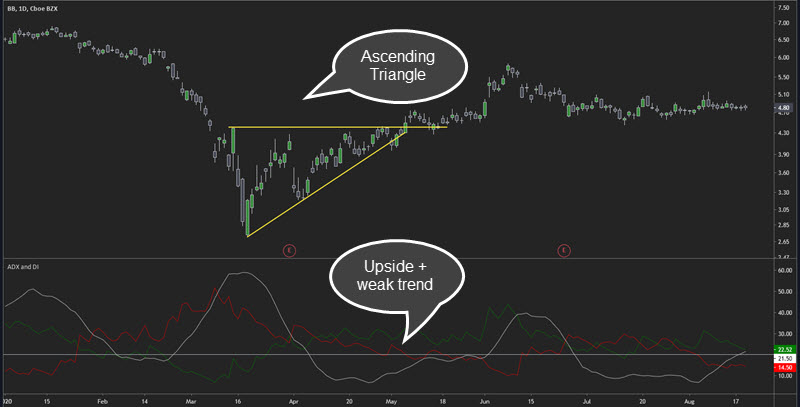
How do you read this trend indicator?
- Red line above green is short
- Green line above red is long
- White line above 20 is a trending market
Let’s look at the area of the ascending triangle.
- Green line is above the red line so looking upside
- Ascending triangle (rising support line into resistance level) is bullish that points to upside
- ADX is below 20 but rising
If you waited for the ADX trend strength indicator to pass 20, you find yourself looking for entries at highs. Understanding price patterns along with reading the DMI and rising ADX, gets you positioned long on a break of the triangle. Price rose 27% from the break of the triangle resistance.
You can see on the left that the DMI lines are crisscrossing while the ADX is below 20. One look at price shows that the indicator is telling you we are in a trading range. You’d use your range trading strategy in those cases.
Wrap Up
What did we cover in this trend indicator article?
- The importance of choosing your time frame for trend direction as you can have differing trends according to time
- Using market structure of higher highs and lows and lower highs and lows is a price action method of determining trend
- Moving averages can be used with different settings and price relation to the average can show strength of trend
- Multiple time frames can be used when trading the higher time frame trend on a lower time frame with MACD
- DMI plus ADX is a trend direction and trend strength indicator
Whatever method you use, ensure it is part of an overall trading strategy that includes risk management.
Thanks for reading. Any questions or comments just pop them in the box below.
3 Comments
Comments are closed.

Yes, all are good indicators. The more different timeframes that support one direction the better.
Comment for Coach Shane. I’m relatively new to trading. My trading platform is Think or Swim by TD Ameritrade. Is there any any way to implement putting outside smoothed Hiken Ashi data into Think or Swim? I think TOS may be proprietary.
Thanks , Rick
I don’t use TOS personally but found this: https://usethinkscript.com/threads/smoothed-heikin-ashi-for-thinkorswim.216/